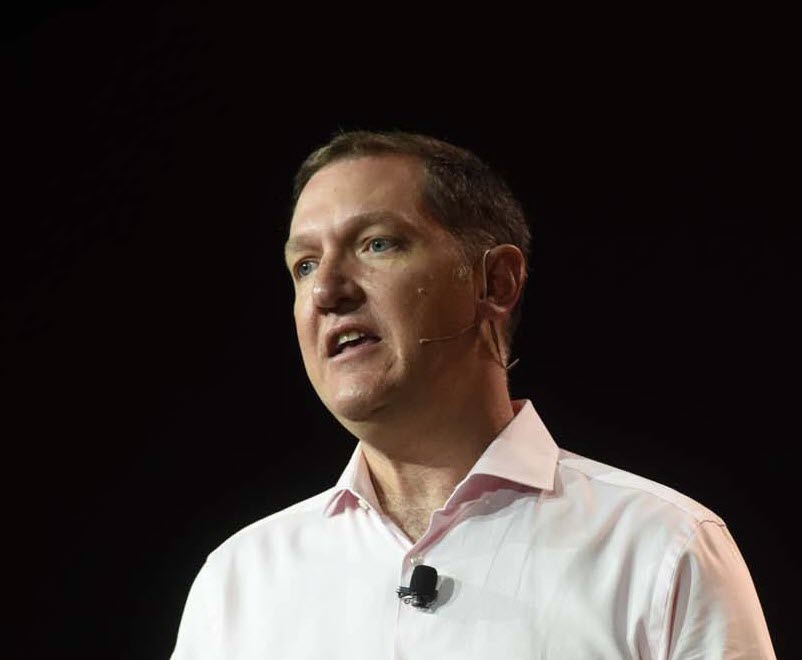 INFRA
INFRA
 INFRA
INFRA
 INFRA
INFRA
Red Hat Inc. blew past consensus estimates on both revenue and profits for its first fiscal quarter of 2018 on a surge in its application development-related business, leading it to raise revenue and earnings estimates for the rest of the year.
After-hours investors applauded by sending the stock up nearly 10 percent.
The Raleigh, North Carolina-based company actually quickened growth in sales of subscriptions for application development tools from the pace it set in its fiscal fourth quarter. Application development-related and other emerging technology subscription revenues were $139 million, up 41 percent year-over-year and slightly above the previous quarter’s 40 percent growth pace. Subscription revenue for Red Hat’s core infrastructure business rose 14 percent, to $458 million, an impressive gain on top of an already large base.
Chief Executive Jim Whitehurst (pictured) said Red Hat is shifting its business from being a low-cost provider of open-source alternative software to a strategic platform for cloud migration. “We’ve moved from having a seat the table with the purchasing department to having a seat at the table with the CIO,” he said. Sales of core infrastructure platforms like Red Hat Enterprise Linux and OpenStack, he added, “provides a tailwind for our other offerings.”
Total quarterly revenue of $677 million was up 19 percent year-over year, the largest first-quarter revenue growth rate in four years. The quarter included 44 deals valued at over $1 million, seven greater than $5 million and four greater than $10 million.
To illustrate the growth in its development and emerging technology businesses, Red Hat said one government agency closed a $5 million contract for the Ansible automation software in the quarter and that six of the $1 million deals included Ansible. Overall, more than 68 percent of million-dollar deals including one or more application development or emerging technology components.
Earnings per share of 56 cents beat consensus estimated by 3 cents. Subscription revenue made up 88 percent of total sales, an important indicator of stability. Another important indicator, deferred revenue, grew 21 percent to $2.05 billion. Operating margins held steady at just under 24 percent.
The company comfortably beat expectations it set in its most recent earnings report, when it said earnings would be in the range of 53 center per share on sales of between $643 million and $650 million. Executives were confident enough in the company’s momentum to raise fiscal 2018 earnings-per-share estimates to between $2.66 and $2.70 without squeezing margins. That compares with consensus estimates of $2.63.
Likewise, the company lifted annual revenue estimates to between $2.785 and $2.825 billion, up 17 percent from the previous year and ahead of consensus estimates of $2.74 billion. The company increasingly appears to be within striking distance of its goal of becoming a $5 billion company by 2022.
Judging by after-hours trading, investors appear to be confident that Red Hat has successfully pulled out of the ditch it fell into two quarters ago, when it missed both profit and revenue estimates and saw its stock drop 13 percent, to less than $69. Since then the share price has more than recovered, nearly touching $99 after-hours today.
Key to the turnaround has been a more intense focus on cloud platforms like OpenStack and emerging application development and DevOps platforms like OpenShift, Docker and Kubernetes. Asked if the OpenShift platform-as-a-service would eventually be a larger business than the more mature OpenStack cloud platform, Whitehurst said it’s a toss-up.
“If you put a gun to my head, I’d say OpenShift because it drives the rest of the portfolio,” he said. “We see good traction with middleware sales after people adopt it.” Even though Red Has has more than 500 OpenStack customers, “if the telco business takes off in a big way, OpenShift could be massive,” Whitehurst said.
Red Hat Enterprise Linux continues to be the cash cow, and it shows no signs of slowing down, executives said. “As applications are being modernized to run in the cloud, the first thing people do is move to Linux,” Whitehurst said. “We see nice, healthy momentum and growth in Linux.”
What’s more, customers that buy platform subscriptions renew at a high rate. “The effort required to renew is very, very low,” Whitehurst said. “I would expect margins to look very, very good in the long term.”
THANK YOU